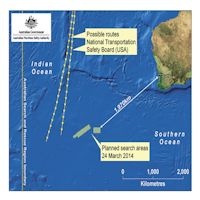Chris Hughes is Professor of Sea Level Science in the University’s School of Environmental Sciences.
“It has been confirmed that the Malaysian Airlines plane that disappeared on March 8 crashed into the southern Indian Ocean. It would be hard to choose a more complicated region of the ocean to be searching for scattered aircraft debris.
The area of the southern Indian Ocean to which the missing Malaysia Airlines flight MH370 has been traced, 1,500 miles west of Australia’s southwestern coast, lies just on the northern flank of the Antarctic Circumpolar Current, a huge ocean current encircling Antarctica. In many ways it is similar to the atmospheric jet stream, or a series of jet streams.
Just as in the jet stream, the strange effect of the earth’s rotation leads to the eastward-flowing currents focusing into narrow bands, like rivers flowing within the ocean. The currents loop into closed eddies that break away from their current and spin off, like high and low pressure systems moving through the atmosphere.
Unlike the atmosphere, these highs and lows are on a much smaller scale, perhaps 100-500km across. Typical flow speeds are around 20cm per second – about ten miles per day – but faster speeds of up to 100cm per second are possible, and the direction of flow at any one time is very unpredictable.
The search area spans both the northernmost “river” of the Circumpolar Current, and a much calmer area to the north where currents are much slower. This means debris could have been scattered and pulled in different directions, at different speeds.
Further complicating things is the effect of the wind. Any floating debris will be directly pushed by the wind, but will also be surrounded by water in the Ekman layer, which is the top 50 metres or so of the ocean in which the effect of the wind is immediately felt.
Here again, the rotation of the earth has an effect which results in water moving (in the southern hemisphere) to the left of the direction of the wind, to a degree which depends on depth. So the wind can cause debris to drift across the deeper ocean currents, generally to the north in this region of prevailing westerlies, but how much of an effect the wind has will depend on how deeply the debris is floating.
It is now more than two weeks since flight MH370 was lost. In that time, debris could have drifted by several hundred miles from where it is presumed the plane hit the water, and the patch of debris could have spread by a substantial fraction of that distance. Even if the debris spotted is confirmed to be from the plane, finding any sunken remains will still be a big challenge.
The ocean in that region is about 3,500-4,000 metres deep, and finding sunken wreckage will involve combing a vast area with advanced sonar imaging technology. Then there is the challenge of reaching it: only specialised equipment can operate at the pressures of more than 350 atmospheres present at such depths, although from that point of view it could have been worse – large areas of the seafloor lie more than 5,000 metres below the surface, with a few narrow trenches beyond 10,000 metres deep.
If the debris is confirmed to be from the Malaysia Airlines plane, a lot of work will remain to be done. It will still be a long time before we are in a position to determine what happened to flight MH370.”
This article was first published in `The Conversation’.

